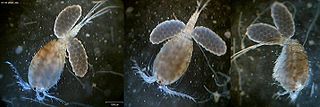Related Research Articles

Diaptomus is a genus of copepods with a single eye spot. It is superficially similar in size and appearance to Cyclops. However it has characteristically very long first antennae that exceed the body length. In addition, the females carry the eggs in a single sac rather than the twin sacs seen in Cyclops. It is a copepod of larger freshwater ponds, lakes and still waters.

Afrocyclops pauliani is an extinct species of copepod in the family Cyclopidae. A single specimen was discovered in 1951 in a small freshwater pool near Antananarivo, Madagascar, but the species has not been seen in collections since.
Afrocyclops is a genus of copepod crustaceans in the family Cyclopidae, containing the following species:
Allodiaptomus is a genus of copepods in the family Diaptomidae, containing the following species:
Arctodiaptomus is a genus of copepods in the family Diaptomidae, containing the following species:
Eodiaptomus is a genus of copepods in the family Diaptomidae, containing the following species:
Heliodiaptomus is a genus of copepods in the family Diaptomidae, containing the following species:.
Idiodiaptomus gracilipes is a species of copepod in the family Diaptomidae. It is endemic to "a pool at Itapura", in São Paulo state, Brazil.
Neodiaptomus is a genus of freshwater copepods in the family Diaptomidae. It contains the following species, four of which are listed as vulnerable species on the IUCN Red List :
Neutrodiaptomus is a genus of copepods in the family Diaptomidae. The Japanese endemic species N. formosus is listed as Data Deficient on the IUCN Red List. The genus Neutrodiaptomus contains the following species:
Notodiaptomus is a genus of copepods in the family Diaptomidae. It is the most widely distributed, most abundant and most species-rich genus of freshwater calanoid copepods in the Neotropics. The genus was erected in 1936 by Friedrich Kiefer for eleven species formerly placed in a wider Diaptomus. Notodiaptomus deitersi was chosen to be the type species by Raúl Adolfo Ringuelet in 1958.
Odontodiaptomus is a genus of freshwater copepods in the family Diaptomidae. It includes the following species:
Thermodiaptomus is a genus of copepods in the family Diaptomidae, containing the following species:
Tropocyclops is a genus of copepod crustaceans in the family Cyclopidae. It contains the following species:

Diaptomidae is a family of freshwater pelagic copepods. It includes around 50 genera:

The Cyclopidae are a family of copepods containing more than half of the 1,200 species in the order Cyclopoida in over 70 genera.
Megacyclops is a genus of copepods, containing the following species:
Cletocamptus is a genus of marine and brackish-water copepods, containing the following species:
Sinodiaptomus is a genus of freshwater copepods in the family Diaptomidae, found in Asia and Palaearctic regions. The Japanese Sinodiaptomus valkanovi has established non-indigenous populations in California, Bulgaria and New Zealand, although only the New Zealand population persists due to destruction of the habitat in California and Bulgaria. The genus was originally described as a subgenus of Diaptomus, containing only Sinodiaptomus chaffanjoni, but now contains five species:

Macrocyclops is a genus of copepods belonging to the family Cyclopidae. There are currently 13 described species found in fresh water habitats throughout the world:
References
- ↑ T Chad Walter (2010). Walter TC, Boxshall G (eds.). "Afrocyclops gibsoni (Brady, 1904)". World of Copepods database. World Register of Marine Species . Retrieved December 4, 2011.